
The Great Dane is a large sized dog breed originating from Germany. The Great Dane descends from hunting dogs from the Middle Ages used to hunt wild boar and deer, and which were also used as guardians of German nobility. It is one of the two largest dog breeds in the world, along with the Irish Wolfhound.
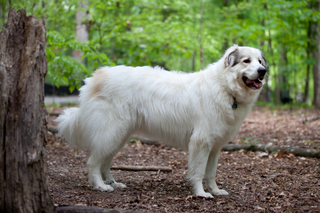
The Pyrenean Mountain Dog is a French breed of livestock guardian dog; in France it is commonly called the Patou. It originates from the eastern or French side of the Pyrenees Mountains that separate France and Spain. It is recognised as a separate breed from the Mastín del Pirineo or Pyrenean Mastiff from the Spanish side of the mountains, to which it is closely related.

The St. Bernard or Saint Bernard is a breed of very large working dog from the Western Alps in Italy and Switzerland. They were originally bred for rescue work by the hospice of the Great St Bernard Pass on the Italian-Swiss border. The hospice, built by and named after the Alpine monk Saint Bernard of Menthon, acquired its first dogs between 1660 and 1670. The breed has become famous through tales of Alpine rescues, as well as for its large size, and gentle temperament.
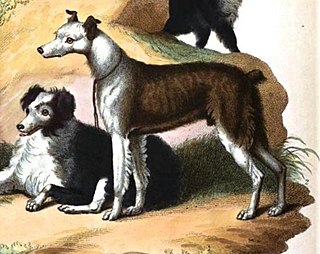
A cur was a dog breed used by cattle drovers in England. The breed is now extinct. In the United States a short-haired dog used in hunting and herding is called "cur-tailed", or "cur" for short.

A mastiff is a large and powerful type of dog. Mastiffs are among the largest dogs, and typically have a short coat, a long low-set tail and large feet; the skull is large and bulky, the muzzle broad and short (brachycephalic) and the ears drooping and pendant-shaped. European and Asian records dating back 3,000 years show dogs of the mastiff type. Mastiffs have historically been guard dogs, protecting homes and property, although throughout history they have been used as hunting dogs, war dogs and for blood sports, such as fighting each other and other animals, including bulls, bears and even lions.
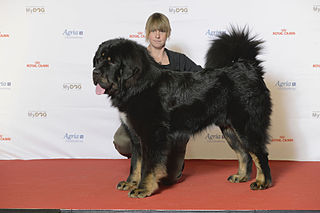
The Tibetan Mastiff is a large size Tibetan dog breed. Its double coat is medium to long, subject to climate, and found in a wide variety of colors, including solid black, black and tan, various shades of red and bluish-gray, and sometimes with white markings around neck, chest and legs.
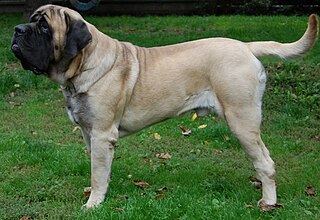
The English Mastiff, or simply the Mastiff, is a British dog breed of very large size. It is likely descended from the ancient Alaunt and Pugnaces Britanniae, with a significant input from the Alpine Mastiff in the 19th century. Distinguished by its enormous size, massive head, short coat in a limited range of colours, and always displaying a black mask, the Mastiff is noted for its gentle and loving nature. The lineage of modern dogs can be traced back to the early 19th century, but the modern type was stabilised in the 1880s and refined since. Following a period of sharp decline, the Mastiff has increased its worldwide popularity. Throughout its history the Mastiff has contributed to the development of a number of dog breeds, some generally known as mastiff-type dogs or, confusingly, just as "mastiffs". It is the largest living canine, outweighing the wolf by up to 50 kg on average.

The Alaunt is an extinct type of dog which came in different forms, with the original possibly having existed in North Caucasus, Central Asia and Europe from ancient times.

The Old English Bulldog is an extinct breed of dog.

The Bully Kutta is a type of large dog that originated in the Indian subcontinent, dating back to the 16th century. The Bully Kutta is a working dog used for hunting and guarding. The type is popular in the Punjab region of India and Pakistan, including Haryana and Delhi, as well as in Maharashtra and Tamil Nadu.

Bulldogs are a type of dog that were traditionally used for the blood sports of baiting and dog fighting, but today are kept for other purposes, including companion dogs, guard dogs and catch dogs. Bulldogs are typically stocky, powerful, square-built animals with large, strong, brachycephalic-type muzzles. "Bull" is a reference that originated in England that refers to the sport of bull baiting, which was a national sport in England between the 13th and 18th century. It is believed bulldogs were developed during the 16th century in the Elizabethan era from the larger mastiffs, as smaller, more compact dogs were better suited for baiting.
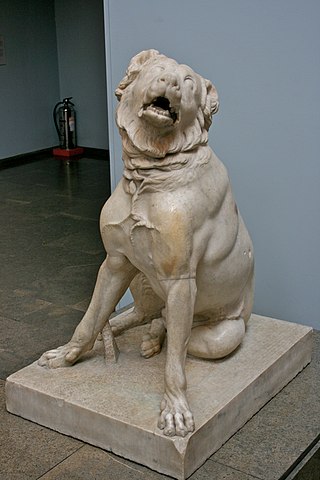
The Molossus was a breed of dog from Ancient Greece.

Barry der Menschenretter (1800–1814), also known as Barry, was a dog of a breed which was later called the St. Bernard that worked as a mountain rescue dog in Switzerland and Italy for the Great St Bernard Hospice. He predates the modern St. Bernard, and was lighter built than the modern breed. He has been described as the most famous St. Bernard, as he was credited with saving more than 40 lives during his lifetime, hence his byname Menschenretter meaning "people rescuer" in German.

Bull and terrier was a common name for crossbreeds between bulldogs and terriers in the early 1800s. Other names included half-and-halfs and half-breds. It was a time in history when, for thousands of years, dogs were classified by use or function, unlike the modern pets of today that were bred to be conformation show dogs and family pets. Bull and terrier crosses were originally bred to function as fighting dogs for bull- and bear-baiting, and other popular blood sports during the Victorian era. The sport of bull baiting required a dog with attributes such as tenacity and courage, a wide frame with heavy bone, and a muscular, protruding jaw. By crossing bulldogs with various terriers from Ireland and Great Britain, breeders introduced "gameness and agility" into the hybrid mix.
Dogs of Roman Britain concerns the presence of dogs within Britain under Roman occupation. Through various excavations in the Province of Britannia, evidence for a variety of uses from dogs has been found. There has been presences of dog remains, figurines of dogs, and use of dogs in religion found among the remains of excavated sites. Along with this are written references to the use of dogs as well.

Dog types are broad categories of domestic dogs based on form, function, or style of work, lineage, or appearance. Some may be locally adapted dog types that may have the visual characteristics of a modern purebred dog. In contrast, modern dog breeds strictly adhere to long-established breed standards, that began with documented foundation breeding stock sharing a common set of inheritable characteristics, developed by long-established, reputable kennel clubs that recognize the dog as a purebred.
Mountain dog is a term used in some English-language names of some breeds and regional varieties of dog, all livestock guardian types.
The Assyrian Mastiff, was a landrace in Assyria. This dog was often used as a livestock guardian against predators and they were bred by the Assyrians and Babylonians for lion and wild horse-hunting.
















